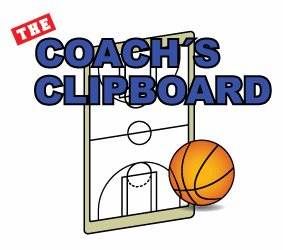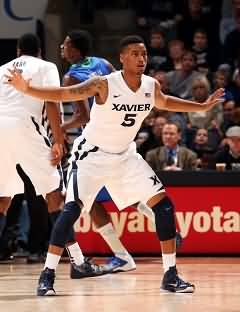Basketball Defense - Basic Man-to-Man Defense
By Dr. James Gels, From the Coach’s Clipboard Basketball Playbook"Helping coaches coach better..."
Disclosure: This page contains affiliate links, which means that Coach's Clipboard receives a small commission (at no cost to you) if you make a purchase using these links.

Good offense wins games; great defense wins championships. When your offense is struggling, good defense can keep you in the game until your shots start falling. How are you going to catch up if you are down 12 at the half? - by playing great defense. Simply scoring more baskets won't do it if you allow the opponent to score also. You must keep the opponent from scoring with good defense and rebounding, to allow your offense to get back into the game.
Everyone has to play good defense, because one weak link will cause the entire defense to fail, and a good offense will eventually find out who the weak defender is. Playing good defense involves hustle, inspiration and perspiration (sweat!). You have to want to play good defense. Defensive skills are fairly easy to learn, unlike some offensive skills, and everyone can learn to become a good defender. If you are a poor, non-aggressive defender, you will hurt your team. Also see Man-to-Man Pressure Defense.
These are the important elements in playing good defense:
Defensive Stance and Focus
Your weight should be on the balls of your feet (not your heels), and your feet should be about shoulder width apart. Keep your knees bent and your back straight. Keep your head up, eyes forward, arms out with your palms up and elbows bent a little. Watch the offensive player's belly-button, especially if he/she is quick and hard to stay with. The offensive player can fake you with a head fake, eye fake, arm or shoulder fake, or a jab-step, but the belly-button will always go in the direction that he/she is going.Man-to-Man Defense - Defensive Slides
When guarding your opponent, slide your feet sideways, using quick, short steps, and don't get your feet crossed. Don't hop. If you get beat in the open floor, don't just yell for help - turn and sprint after your opponent. Once you get in front of your man again, get back into your defensive stance.Defensive slides from Coach Vivian Stringer:
Man-to-Man Defense - Close-out on the ball
Defenders must learn to "close-out" on the player with the ball. Once the offensive player receives the pass, the defender should rush toward the ball-handler in a low stance. The last several steps should be quick, choppy steps to stop your momentum (so the defender doesn't dribble around you). Your baseline line foot should be back in order to force the ball-handler toward the baseline.As you approach the ball-handler, snap your shoulders and head back to help slow yourself down. We teach our defenders to close-out with the inside hand (closest to the baseline) high, in order to contest the outside shot, and the outside hand low (this helps prevent a cross-over dribble into the middle).
Some coaches teach closing-out with two-hands high, expecially against a good outside shooting team.
Man-to-Man Defense - On the Ball Defense
If the ball is at the top of the key (point), over-guard toward the offensive player's strong side. If your man likes to go right, force him/her left. If he/she is adept at going either way, then just play straight-up. If the ball is on the wing, try to force it to the baseline. Drop your outside foot back a little toward the baseline and overplay a little toward the offensive player's high side. Once at the baseline, stop the ball, and do not allow any further penetration along the baseline.Keep the palm of your lead hand facing up. Try to get at the ball from below, not by slapping down it, which often results in a foul. Your other hand should be in the passing lane. Slide with your opponent, try to get him/her to stop the dribble, and then close in and apply pressure.
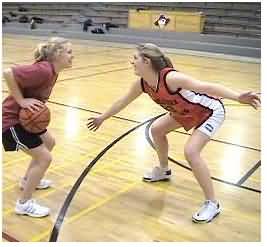
Don't "reach-in". This causes you to lose your balance and stance, and you are easily beaten. Reaching-in also results in fouls. Don't get into the bad habit of reaching-in and taking a swipe at the ball as the offensive player dribbles around you. Instead move your feet, hustle, stay with your man, "guard your yard", and prevent him/her from getting to the basket. If you get beat, sprint after the offensive player and beat him/her to a spot where you can resume your defensive stance, or perhaps you can back-tip the ball loose.
Man-to-Man Defense - Denial
Clog the passing lane and prevent the player you are guarding from getting the ball, that is, "deny" him/her the ball. When guarding an offensive player who is one pass away from the ball, you should be in denial. Denying your man the ball, keeps him/her from scoring. Play the passing lane and stay between the player you're guarding and the ball, about a step from your man, toward the ball. Place your foot and hand nearest the ball slightly forward, and turn the palm of your hand toward the ball, so that you can reject any incoming passes. Be in a position to see both your player and the ball. If the ball-handler stops the dribble, you have a "dead ball situation" and everyone should in close on their man, in "full-denial".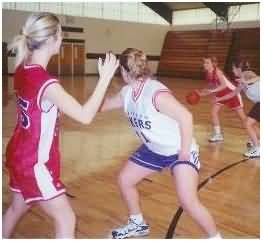
Full-denial
In "full-denial", the defensive players should be "on the line". To explain this concept, imagine a line extending from the ball to the person you are guarding. In full-denial, you should position yourself so that you are on this line, body toward your man, but with head and eyes turned toward the ball, and your ball-side hand up in the passing lane.
If your man is a long distance, or two passes away from the ball-handler, you can play a little "up the line", that is a little ways from the imaginary line towards the hoop.
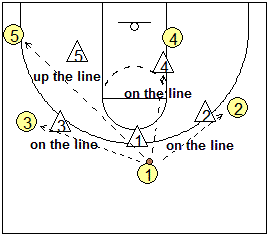
The distance, or spacing, up the line depends upon the speed and quickness of the defender and the distance his/her man is from the ball. On a long pass, the defender should still be able to move toward the line and intercept the pass. If instead the defender initially played "on the line", his/her man could make a back-cut and get open. Playing a little "up the line" prevents the back-cut, and still allows for the interception.
Man-to-Man Defense - Help and Recover.
Diagrams E and F below teach how to give help and recover on the perimeter. Rather than play a "full-denial", defenders one pass away play a little up the line and step or two toward the ball in order to help stop dribble penetration. Here O1 tries to dribble-penetrate. The X2 defender "jumps to the ball" and gives help and O1 is prevented from penetrating. O1 passes back out to O2 (Diagram F). The X2 defender has to rotate quickly to recover to on-ball defense on O2, and the X1 and X4 defenders are now in deny, a little up the line and a step or two toward the ball, while the X3 defender moves into help-side (Diagram F).Important point: when X2 helps on the dribble-drive, he is not attempting to double-team the ball, but rather just tries to stop it from going inside, and then quickly recovers to his man.
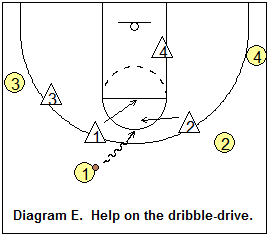
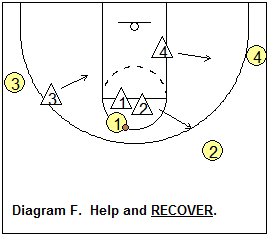
Man-to-Man Defense - Helpside Defense
When your opponent is two or more passes from the ball, you should be in "help-side" position. This will put you in position to help your teammates against the ball penetrating the paint. This involves dropping off your man some (but without losing sight of him/her), and sagging toward the ball-side.In the diagrams below, see the imaginary red "help-side line" which goes through the middle of the lane. Many coaches teach that if the ball is above the free-throw line, the help-side defender should have one foot in the lane (Diagram A).
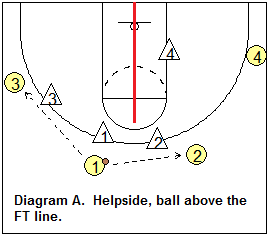
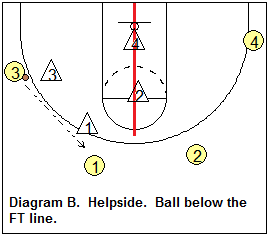
If the ball is below the free-throw line, one foot should be touching or staggering the help-side line. Stay between the ball and your man. Be ready to help defend against another player driving or cutting to the hoop, and "help" your teammate who may have gotten beat. Once the ball comes back to within one pass from your player, you sprint back to your man. If the ball is skip-passed to your player when you are in helpside, quickly close-out and play "on-ball".
Remember, good defense is "team defense", whether man-to-man or zone defense. Here is a good quote: "The best man defense looks like a zone and the best zone defense looks like a man.
Man-to-Man Defense - Defending the Low Post
There are three positions the defender can assume when defending the low post player.Playing behind the offensive post player.
Here the defender plays directly behind the offensive player. This may be advantageous if your post defender is much taller than the offensive player, and has a good chance of altering or blocking the post player's shot.But do not let the offensive player back you down under the basket. Use your legs (use a strong stance with knees bent) and your lower body strength to keep the offensive player out - but do not put your hands on the post player's back as you may get called for a pushing foul.
Full-fronting the low post player.
Here the defender moves directly in front of the offensive post player, between him/her and the ball, and denies the pass. The wing defender should put pressure on the ball in order to make the pass to the low post, or the lob pass, more difficult.Fronting may backfire if the offensive player is taller and can easily seal for inside position and get the high lob pass. Another disadvantage is the defender is out of position for the rebound, and the post player may be able to score just by sealing for inside position and receiving the inside pass, or by getting the rebound and put-back.
Three-quarter (or one-half) front the low post player.
This is probably the best method. Instead of directly fronting the low post player, the defender "straddles" him/her with one foot in front and one in back, standing sideways to the offensive player with one hand in the passing lane.If the ball is below the free-throw line extended (in the corner-wing area), the defender should play on the baseline side of the post player, making contact with the post player's inside (baseline) shoulder, and with the left arm and hand out in the passing lane.
If the ball is passed out on top (above the free-throw line extended), the defender should slide chest to chest with the post player and move to the post player's high-side (or lane-side) shoulder, again with a hand up at all times in the passing lane.
Man-to-Man Defense - Trapping
In trapping, one defender first has to stop the dribbler, often along the sideline or baseline, or in one of the "trapping zones" (see below).Once the ball is stopped, the second defender sprints over and double-teams. They obscure the ball-handler's view, and get into the passing lane. Their knees are adjacent to each other to prevent the ball-handler from "splitting" the trap.
The position of their hands should be the same height as the ball. If the offensive player holds the ball high to "throw over the top", the hands should be high. If the ball is low, the hands should be low to prevent the bounce pass.
Do not reach in and foul! This changes a good situation into a bad one (now the player shoots free throws). Instead, the trappers should make it hard for the player to pass and try to force a bad pass, or go for the 5-second call.
Try to trap in these "trapping zones".
- The yellow zones catch the player in the corner, which is ideal.
- The blue zones are good trapping zones because the offense has to worry about the 10-second count.
- The red zones are excellent trapping zones, since the offensive player cannot retreat across the 10 second line.
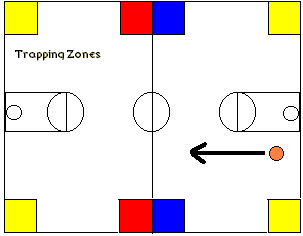
For defending against screens and other more detailed points, see "Teaching Man-to-Man Pressure Defense"
Related pages:- Man-to-Man Pressure Defense
- Shell Drill
- Man-to-Man Breakdown Drills
- Man-to-Man Positioning Drill
- 1-on-1 Drill
- Defensive Close-Outs and Drills
